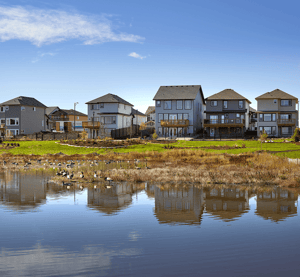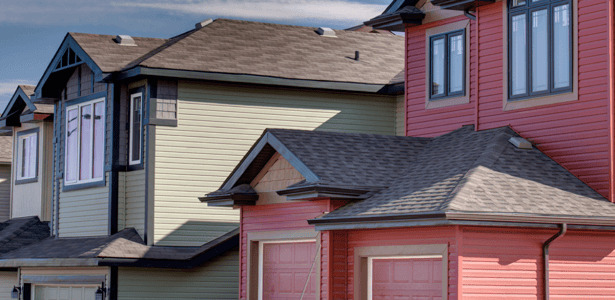One of the exciting things about being in the market for a brand-new home is that you can take advantage of all of the latest trends in building techniques, materials, and philosophies.
Much more than just simple cosmetic changes, new and trending features of home construction include deep-seated beliefs that people should live in homes that are comfortable and spacious yet simultaneously have a smaller environmental footprint.
Below is a list of some of the hottest trends to look out for when you're in the market for buying a brand-new home.
Net Zero Energy Homes
A Net Zero Energy (NZE) home is one that produces as much energy as it consumes over the course of the year. At the moment, there's no provincial mandate that new homes in Alberta conform to the NZE standard, but it is undoubtedly the wave of the future.
NZE homes are already starting to be built, taking advantage of advances in solar power, wind power, and other sustainable energy sources to create a surplus of energy that can be then sold back to the utility companies.
In addition to feeling good about your more environmentally-friendly home, think of how the money you save can help you pay your mortgage off faster!
 Eco-Friendly Homes
Eco-Friendly Homes
More than just using less energy after the fact, true eco-friendly homes take advantage of the concept of "green building," or using new home building materials to save you money by dramatically reducing the home's energy consumption. Whether it's manufacturing new homes using recycled materials like steel and polypropylene or having an effective plan in place to recycle waste during the construction process, today's homes are increasingly moving towards a more sustainable model.
Other eco-friendly building techniques include using extremely efficient insulation to reduce heat and energy loss (especially during the colder months), low-flow washing machines, showers, and other appliances to reduce water consumption. Energy-efficient electrical appliances like refrigerators, stoves, and heating systems that utilize less energy without any sacrifice in quality or output are also used.
Healthier Homes
During the 1960s into the mid-1970s, a combination of geopolitical events and a rising awareness about environmental impact led to dramatic changes in the way homes were built. In an effort to improve efficiency, building trends in the 1970s went towards creating "closed homes," effectively sealed off from the outside world in an effort to reduce heat and energy loss. Unfortunately, these "closed homes" often increased indoor air pollution as dust, microbes, mildew, and chemicals off-gassing from building materials accumulated inside the home.
Today's building trends combine energy efficiency and minimal loss of heat with designs that are much better suited to improving indoor air quality. Whether it's using more advanced filtration systems for heating and cooling, a reduction in building materials that off-gas chemicals, or better circulation of the indoor environment, today's homes are far healthier to live in.
Building techniques like insulated concrete forms are ideal for the climate of Alberta as they are less susceptible to mould and mildew than concrete yet do not off-gas dangerous chemicals like chlorofluorocarbons (CFCs) and hydrochlorofluorocarbons (HCFCs).
Smart Homes
The internet has gone from a curious novelty to something akin to a basic utility service like gas, electricity, and water. As the internet steadily becomes more ubiquitous in the everyday facets of our lives, so too have the items inside homes started to connect to the internet.
Known widely as the Internet of Things (IoT), this concept refers to kitchen appliances, lights, window shutters, door locks, security systems, heating and cooling systems, entertainment systems, and other gadgets all being connected to and coordinated via the internet. The growing trend in new home construction is to offer homeowners a complete range of systems and services that can be programmed to both reduce energy consumption and to improve the comfort of the residents. Adding smart tech to your home can even increase the value of your home.
 Smaller Yet More Comfortable Homes
Smaller Yet More Comfortable Homes
Although an increasing number of Canadians are now working from home, more and more home buyers are choosing to do more with less square footage. Even setting aside changes in down payment requirements and mortgage loan rates, Canadians are increasingly seeing the advantages of downsizing and choosing smaller homes that are cheaper to heat and cool but have innovative open floor plan designs that make them more flexible and adaptable.
An Increase in Prefabrication
The concept of prefabrication (or "prefab" as it is commonly known) is when builders use parts or elements of a house that were constructed off-site. Common examples of this include prefabricated walls that can instantly be connected to a foundation, and roof.
Prefabricated building elements allow builders to quickly assemble a home saving a lot of time and closing up the homes' building envelope from the outside elements.
Today's home builders are looking towards the future with a strong commitment to both reducing the environmental impact of the house as well as building "smarter" homes with better designed internet-connected devices, appliances, and systems that make building a new home worth waiting for.
How will your new home be constructed?



 Eco-Friendly Homes
Eco-Friendly Homes Smaller Yet More Comfortable Homes
Smaller Yet More Comfortable Homes
